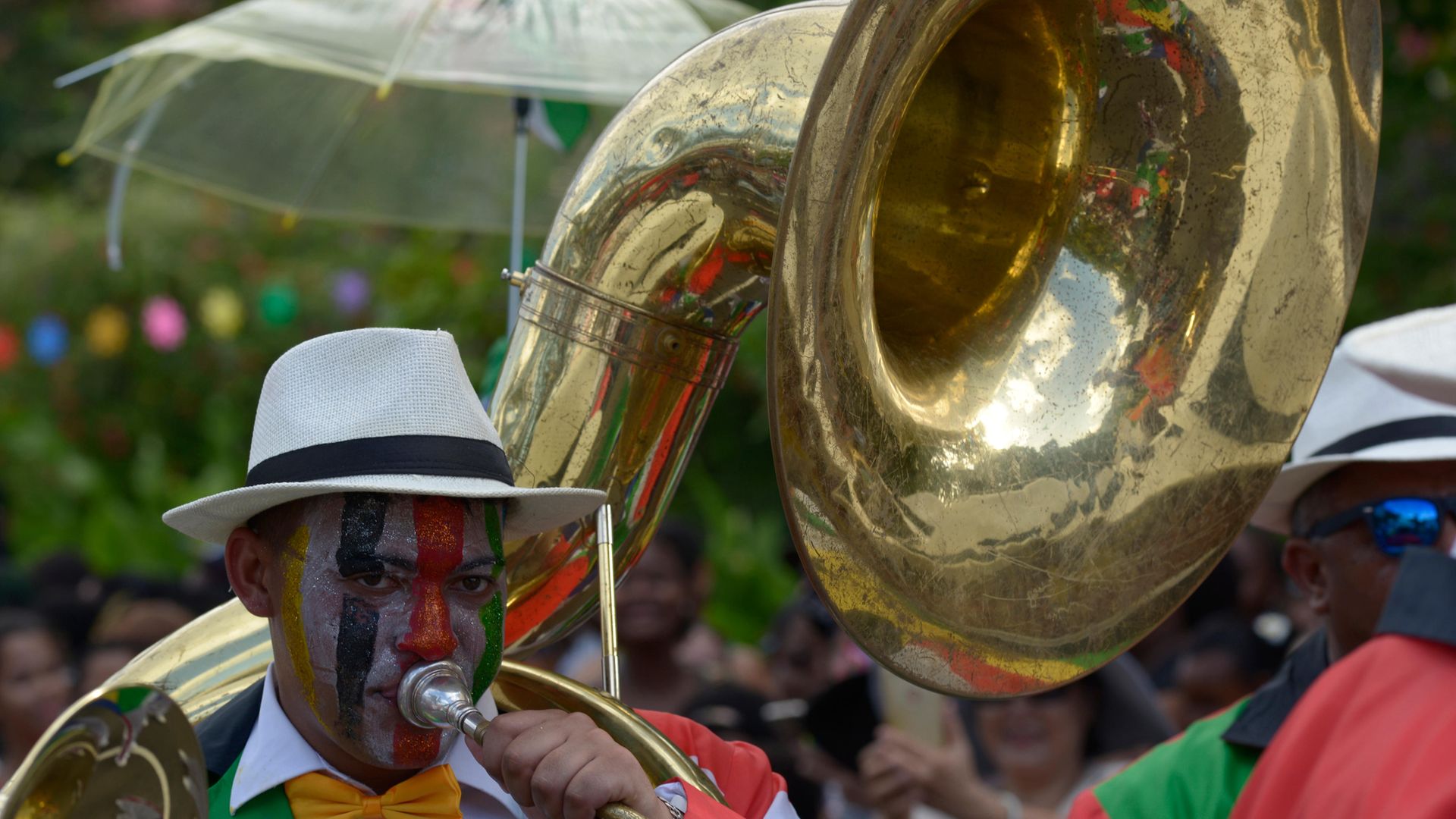
The Seychelles are a place where musical cultures from every part of the world – African, Indian, Polynesian, Arabic, Far Eastern and European – truly harmonise
“The real richness of these islands is our cultural heritage,” Seychellois musical legend Patrick Victor has said. That is a cultural heritage that ranges far beyond the island of Mahé, smaller than most cities at just 16 by 10 miles, but the largest of the 115 islands of the Seychelles.
It is home to over a quarter of the Republic’s population of under 100,000 people, and its capital, Victoria. On the slaving and trade routes, the island was settled by the French in the mid-18th century and claimed by the British in the early 19th century, and the Seychelles’ shared history of colonisation intimately ties it to the Mascarene Islands of Mauritius, Rodrigues and Réunion, despite being more than 1,000 miles north of them.
Victor, whose Seychellois Creole-language music was important in the formation of a national identity after independence came in 1976, indicated this symbiotic relationship on his song Koste Pep Losean Endyen (‘People of the Indian Ocean, Unite’), which anticipated Victoria’s inaugural Creole Festival in 1985.
And while the upbeat sounds of the Seychelles suggest little about the country’s turbulent history – the annexation of three of its islands to the British Indian Ocean Territory, along with the Chagos Islands, in the 1960s; the coup that installed France-Albert René as the head of a one party socialist state in the 1970s; the dramatic South African coup led by the British mercenary ‘Mad’ Mike Hoare in the 1980s – its music has been forged through colonial subjugation of the whole region.
Séga is a genre that illustrates the Seychelles’ musical interdependence on the Mascarenes, having originated in the meeting of the culture of the African slaves of the Mauritian plantations and the European polka and quadrille dances.
Once associated with sorrowing and protest, it now brings more readily to mind a colourfully-costumed, hip-swivelling dance which gives the casual observer little clue of its origin.
In the Seychelles itself, Jean-Marc Volcy – an inductee of the ‘Wall of Fame’ at the National Cultural Centre in Victoria and board member of the National Arts Council there, has built a career on modernising séga, his Gou Kréol (1994) reflecting on the common Creole culture across the Indian Ocean.
But séga also gave rise to a genre the Seychelles claims as its own – the moutya. A deeply communal performance of dance and music, the moutya’s characteristic flat goatskin drum is tuned by being warmed by the heat of the open fire around which the gathering takes place and is joined by improvised call and response singing. In recent years Victoria has been at the heart of efforts to preserve this sound of more than 200 years’ history.
There were thousands of slaves on the Seychelles islands by the early 19th century, and the moutya – derived from a Bantu word – arose in circumstances of severe oppression.
The French Code Noir laid down the law for slaves in the colonies and forbade expressions of African culture. The moutya dances where slaves fraternised were accordingly held in secret or not at all and while the coming of the British removed the tyranny of the Code Noir, the new colonial authorities were just as perturbed by a form of cultural expression they didn’t understand and could not control.
Just like the maloya style of Réunion, associated with the independence movement and that island’s Communist Party, and banned by the French authorities right up until Francois Mitterrand became president in 1981, the Seychellois moutya remained controversial well into the 20th century.
The 1935 penal code forbade “the beating of drums or tambours or the blowing of shells, etc., at night after 9 p.m. within the town of Victoria and a distance of one mile outside the limit thereof”. The law was only removed from the statue books in 2018, by which time even many Seychellois perceived the moutya as vulgar and embarrassingly backward.
Today, moutya is the focus of cultural preservation efforts in Victoria. Patrick Victor, who celebrated the moutya drum on his first ever song, Tambour Moutia (1975), pioneered the moutya revival in the 1990s and has since proclaimed that “moutya is our link with our ancestors”.
He has spearheaded efforts to keep the genre alive, giving drum lessons in local primary schools and acting as a cultural ambassador for the Seychelles from an office in Victoria while also operating his recording studio in the Bel Ombre district.
Meanwhile, the National Conservatoire of Performing Arts, in the Victoria district of Mont Fleuri, has launched moutya drum workshops taught by veteran Seychellois performer John Wirtz.
Victor has also professed a desire to preserve another song and dance form particular to the Seychelles, kanmtole, calling it “our rich French heritage”, and it is among the styles played by local musicologist David André and accordion player John Vital.
Meanwhile, their sweet-voiced contemporary Jenny de Letourdie sings the European-influenced romances de l’ancienne France. But a younger generation have looked not to the styles of the Seychelles’ past but to the Caribbean for their influences.
A new age for Seychellois music came when the reggae-influenced San ou (La Rivière) by four-piece Dezil’, fronted by a 16-year-old Sandra Esparon, and produced by French electronic music pioneer Philippe Besombes became a smash hit in France in the summer of 2005.
The song climbed to No.2, spending 15 weeks in the Top 10, while the sun-drenched video was ubiquitous on French TV that year. Music was maintaining a cultural link between the former colonial power and its old possession, even if its sound came from somewhere else altogether.
Esparon has gone on to solo success, and not just in the Seychelles, gracing stages in France like the historic Casino de Paris and winning awards at the Les Voix de l’Océan Indien Awards held annually on French soil on Réunion.
But she has continued to embrace the sounds of the Caribbean, from zouk to ragga. When Esparon won Best Female Artist at the Seychelles’ Cable Tunes Awards in 2018, her male counterpart was Vincent Eliza, aka Mercenary, who made his debut in 2006 in a collaboration with Seychellois dancehall artist Jahrimba, but has since ranged over zouk, R&B and reggae, always sung in Creole.
The Seychelles’ music melting pot is indeed rich, and rarely are a country’s diverse cultural influences so concretely reflected in the built environment of its capital.
Victoria truly bears the marks of its past on its skin, from the French colonial villas, to the incongruous replica of Little Ben from London’s Victoria Street erected in the centre of Victoria in 1903 when the islands became a British crown colony, and the technicolour Hindu temple on central Quincy Street, named after Jean-Baptiste Queau de Quincy, head of the French colony for 30 years.
Victoria is where cultures from every part of the world – African, Indian, Polynesian, Arabic, Far Eastern and European – truly harmonise.
CREOLE CARNIVAL
Victoria’s Creole Festival, held each October, is some 35 years old while the city’s Carnival was a late comer, beginning only in 2010. Seven years later, these two major events for the Seychelles were merged and it is now one of the world’s major Carnivals, welcoming entrants from across the Creole world to participate in three days of colour, music and celebration.
What do you think? Have your say on this and more by emailing letters@theneweuropean.co.uk










